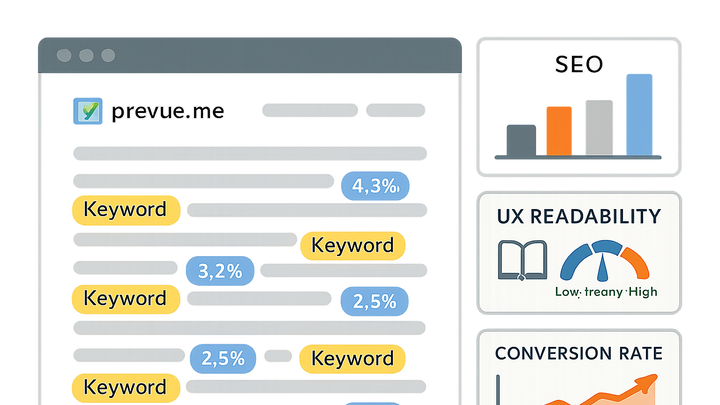Published on 2025-06-29T22:15:02Z
What is Keyword Density? A CRO, UX, and SEO Guide
Keyword Density measures the percentage of times a target keyword appears on a webpage relative to the total number of words in the content. It serves as a fundamental metric in SEO, signalling to search engines how relevant your content is to specific queries. Beyond SEO, keyword density impacts user experience (UX) by influencing readability, and it can affect Conversion Rate Optimization (CRO) through aligning content with user intent. Maintaining a balanced density helps avoid search penalties and ensures your text flows naturally for readers. Tools like Prevue.me offer automated critiques, highlighting overuse or underuse of keywords and offering actionable recommendations to optimize lead generation. This guide covers calculation methods, best practices, common pitfalls, and how to leverage Prevue.me to refine your keyword strategy.
Keyword density
Measures the ratio of keyword occurrences to total words, guiding SEO relevance, UX readability, and CRO effectiveness.
Why Keyword Density Matters
Understanding keyword density is essential for aligning content with search algorithms, improving user readability, and achieving conversions.
-
Seo relevance
A balanced keyword density signals topic focus without over-optimization, helping search engines rank your page appropriately.
- Search algorithm signals:
Search engines analyze keyword frequency alongside semantic context to assess page relevance.
- Semantic context:
Including related terms enhances topic coverage and supports keyword density without exact repetition.
- Search algorithm signals:
-
User experience (ux)
Proper keyword distribution ensures content flows naturally, maintaining readability and user engagement.
- Readability and flow:
Overusing keywords can disrupt reading patterns and distract users from your core message.
- Readability and flow:
-
Conversion rate optimization (cro)
Strategic keyword placement aligns content with user intent, guiding visitors toward conversion actions.
- Cta alignment:
Matching keywords within call-to-action copy can improve click-through and lead generation.
- Cta alignment:
How to Calculate Keyword Density
Calculating keyword density involves a simple formula but requires clarity on what counts as content.
-
The basic formula
Use (Keyword Count / Total Word Count) * 100 to derive the keyword density percentage.
- Keyword count:
The number of times the exact keyword appears in the main content body.
- Total word count:
All words in the content, including headings and paragraphs, but excluding code or meta tags.
- Keyword count:
-
Manual vs automated methods
Short articles can be checked manually, while tools like prevue.me automate the process for longer pages.
-
Content scope decisions
Decide whether to include titles, subtitles, image alt text, and meta descriptions in your word count.
Best Practices and Common Pitfalls
Following best practices helps you maintain ideal density without falling into common traps.
-
Optimal density range
Aim for 1–2% density for primary keywords to balance SEO effectiveness and readability.
-
Avoiding keyword stuffing
Excessive repetition can lead to search engine penalties and degrade the user experience.
-
Leveraging synonyms and lsi keywords
Use related phrases to enrich content context and reduce repetitive phrases.
Using Prevue.me for Keyword Density Optimization
prevue.me provides actionable critiques to refine keyword distribution, boost SEO rankings, and improve CRO and UX metrics.
-
Real-time keyword analysis
Instantly measures keyword density and highlights areas of underuse or overuse within your content.
-
Actionable recommendations
Offers precise suggestions on adding or removing keywords to achieve optimal density.
-
Integration with ux & accessibility insights
Combines density analysis with UX and accessibility feedback to ensure holistic content optimization.
